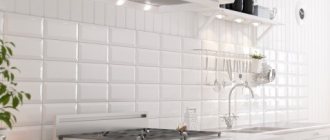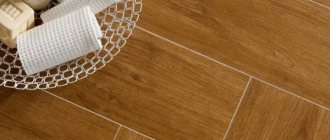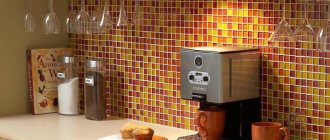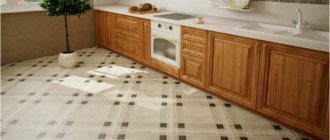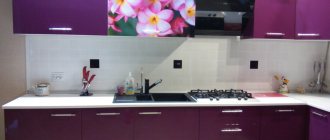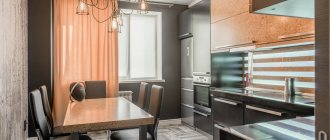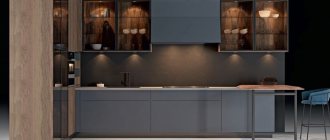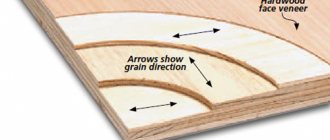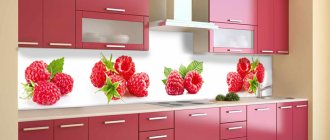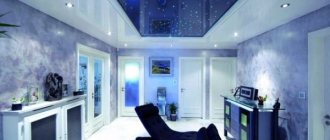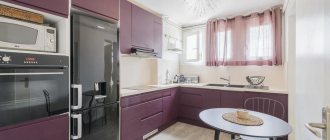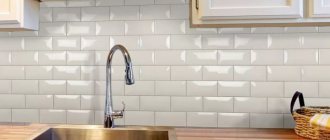A modern kitchen backsplash can be completely unique! You have a choice between dozens of popular materials, hundreds of prints and millions of shades. Designers advise first of all to select a specific option for the kitchen set, its style and facades.
But it is also worth considering the lighting of the room, floor finish, type of interior doors and even the color of household appliances. In our article you will learn exactly how professional interior designers select different apron options for the kitchen. We will reveal all their secrets.
Fashionable cladding is often composed of several colors and has an ornament
Aprons made of tiles and porcelain stoneware
Perhaps the most common finishing option is tile.
Designers prefer this option to others, since the material is durable, has all the necessary protective qualities, is easy to care for, and the variety of color and shape palettes allows you to correctly fit the resulting panel into any interior.
Combining tiles
One of the working finishing options is to combine ceramic tiles with other materials; these can be panels made of plastic, wood, metal, mosaic and other inserts. Typically, tiles are used to decorate sections of the wall above the stove, sink, and cooking area. The remaining part is decorated with less moisture-resistant and more easily soiled finishing materials. It is possible to cover the wall with wallpaper, preferably washable. All these tricks reduce the cost of repairs and provide additional options.
How to choose?
The first thing you should pay attention to is the surface texture. Matte and semi-matte tiles are easier to clean; plaque stains and greasy drops are less visible on them.
Glossy tiles are well suited for a small kitchen - they create an additional effect of a mirror surface, visually expanding the space.
It is better to avoid embossed tiles for the kitchen on the apron - such tiles are difficult to clean from limescale.
Secondly, this is what the manufacturer himself writes on the box. The product must indicate how resistant the tile is to high temperatures, shocks, and treatment with household chemicals. You should not take material that is not suitable for the kitchen according to its characteristics.
We recommend reading:
Features of choosing and purchasing a designer kitchenWallpaper design for the kitchen-living room in a modern style 2022
- Materials for kitchen countertops
The third parameter is checked directly at the time of purchase. The kitchen backsplash has a small area, so each tile will be visible: it is worth checking the tiles for chips and cracks, as well as for color matching (products from different batches may differ).
Another detail that is indirectly related to tiles, but on which you should not skimp, is grout. It should not only match the color of the tiles, but also be resistant to mold.
Important Tips
There are a number of things to consider when planning the size of your splashback. For example, the apron must extend a few centimeters under the installed headset.
Using a plinth, it is also recommended to protect the joint formed between the tabletop and the apron itself.
Otherwise, water will constantly flow onto the lower cabinets, which will soon lead to the formation of fungus.
How to decorate the Easter table - ideas, tips for decorating the Easter table, photosHow to decorate a table for March 8: photo of table setting, decoration of dishes
Curtains for the kitchen with a balcony door: how to choose the ideal option
When decorating a backsplash, you should never use various porous materials, such as unglazed ceramic tiles.
Otherwise, large quantities of moisture will constantly accumulate in the pores. In addition, washing such a surface will be extremely inconvenient, and after a while mold will appear.
It is best to choose an even, smooth apron without prominent joints and seams, because they usually also contain various dirt and moisture, and cleaning them means wasting a lot of free time, which, on top of everything else, is quite difficult to do.
What to choose?
The main advantage of tiles is its diversity. Any style, any purpose chosen by the designers can be embodied in this material. But if classic white can fit anywhere, then what about more interesting options?
Recently, panels made of square patterned tiles have become popular. It is better to give preference to Eastern and African motifs - bright, intricate ornaments will attract attention and dilute the severity of modern neoclassicism, harmonize the boho style, and, of course, will be appropriate in their national style.
For currently fashionable Scandinavian kitchens, the decor is made from “hog” shaped tiles. The emphasis is not on color, but on the method of laying tiles: straight, imitation brickwork, vertical, checkerboard, diagonal, herringbone.
The color can be any, but preference is given to white and some “pure” spectral colors: red, blue, black.
We recommend reading:
Wood-look kitchen design in a modern style, premium wood-look kitchen design options, DIY wood kitchen from start to finishKitchen in neoclassical style
Lamps above the dining table - design tricks
An apron using the patchwork technique is made from small square or rectangular tiles. Unlike a patterned backsplash, patchwork creates a patchwork effect: each tile has a finished pattern. The ideal solution for Provence style.
The once popular mosaic has changed - square pieces have faded into the background. Now geometrically complex arabesques, small tiles in the shape of fish scales, pentagons and other experiments with mosaic shapes are relevant. This is a rather expensive and time-consuming finishing option, but it looks really amazing.
Separately, it is worth mentioning the use of porcelain stoneware. The characteristics of the material allow it to be used to imitate a marble pattern. This option is suitable for spacious, bright kitchens.
Natural stone
Natural stone is a natural finish, great for kitchen backsplashes in country and eco-style rooms. Its advantages: environmental friendliness, beauty of textures, originality when used in decoration. Among the negative aspects are the high cost, the presence of many pores and cavities that are difficult to clean, and the high specific gravity of the material.
The texture and pattern of the stone depends on the rock that was used; the color ranges from light gray, beige to dark brown, gray, chocolate. Its tiles can be of regular geometric shape - rectangles, or abstract. They are placed close to each other or, for greater relief, wide seams are left, which are grouted with contrasting, lighter grout, and varnished. The general country style of the kitchen, in addition to stone aprons, should be supported by other natural materials - wooden furniture, natural carpets, curtains.
Plastic panels
Polyvinyl chloride panels appeared on the market relatively recently, but have already earned people's love. Making a kitchen apron from plastic is quite simple, quick, and most importantly, you can fit into even the most modest budget.
However, it is worth immediately noting that this option is only suitable as a temporary one, since the operational characteristics of the material will not allow it to serve for more than 5 years.
We recommend reading:
Why are kitchens without upper cabinets so popular?Postforming countertop for the kitchen, material features
- Kitchen design 9 sq m 2020-2021: new items and trends in real photos of interiors
MDF boards
MDF boards - stands for finely dispersed fraction, these are sheets of material consisting of compressed medium-length wood fibers. As a finishing touch for the apron area in the kitchen, they are of little use because they do not have moisture or heat resistance and are difficult to clean. Can be used after treatment with impregnation, or for individual areas of the kitchen. Painted MDF panels are the most resistant. When choosing and purchasing, pay attention to the type of impregnation and the quality of the pressing, the absence of cracks and chips into which moisture can penetrate. This is one of the inexpensive finishing materials. It can be attached directly to the wall, or using guides to level the curvature of surfaces. They will fit well into classic and country interiors.
How to choose?
All plastic for a kitchen apron can be divided into two groups: special ready-made panels for the kitchen and regular PVC lining.
It is preferable to choose from special options, since the panels have fewer joints during installation and have additional factory lamination, which is more resistant to aggressive environments.
The lining is suitable for non-standard apron sizes, as well as for walls with large irregularities, which are costly or impossible to eliminate.
Regardless of the manufacturer’s guarantees and the specified characteristics of the material, the plastic behind the stove and sink is additionally protected with fire-resistant glass screens.
In the first case, this saves the panel from overheating, peeling and melting, in the second - from excess moisture and mold.
In the photo, kitchen aprons made of plastic always look better, so it is better to make your choice not from a catalog, but “in person.”
In addition to the panels, it is better to purchase a corner edge that covers the lower edge of the apron. This will prevent dirt and grease from seeping between the wall and the kitchen furniture.
Technical nuances of choosing an apron
Apron area dimensions
The standard height of the apron is 50-60 cm, depending on the height of the household and the type of stove. If tiles are used, then the standard is 30+30+0.1 cm because a height of 30 cm is the standard size of the tiles plus the seam between them. Although now this rule is not strict and there are many sizes of tiles. If the hood is not built-in, then it is placed at a distance of 70-80 cm, which means the apron will be higher. This is important to consider if you are going to make a skinal from glass because... in this case, production will cost a little more, or you will have to finish the wall between the edge of the glass and the hood with something. When calculating the height, take into account 2-3 centimeters of overlap at the top so that the apron goes behind the cabinets.
The work surface should run along the entire perimeter of the kitchen, and not be limited to islands behind the sink and stove. Although water and dirt get behind the sink and stove more often, other places are still not safe. This is not where you need to save money.
If the sink is in the corner of the kitchen, use the apron to touch the perpendicular wall - the areas around the sink are always the dirtiest.
Apron design and color
The color of the apron itself is important for kitchen design, but not for practicality. There are many types of dirt in the kitchen, so no matter what color of backsplash you choose, there will be contrasting stains that will be visible on it.
Therefore, the most important thing in an apron is texture. The texture should not be uniform because... Any stain will be immediately visible on it. Conversely, on a contrasting and heterogeneous texture, small spots are not visible at all. The best option is to imitate various natural materials: concrete, marble, wood, stone. Or any patterns, in 2022 patterns are in fashion and are often used in Scandinavian style kitchens.
Light tiles are much more practical than dark ones, because... Most of the stains are wet, and when the water dries, salt stains remain. Although light tiles are a workable option, the color of the grout for the backsplash should not be white. Dark shades of gray are best in terms of appearance and practicality (article about gray kitchens). White tiles with dark gray grout look quite good:
If you want something bright, look in advance at the photo of the curtains in the kitchen and separately with the balcony door. Skins and textiles are the 2 best accents and they should be combined.
If you are going to do a kitchen in monochrome colors, keep in mind that you will always have a lot of cooking items that are not always easy to find in black and white. It's a good idea to combine a monochrome kitchen and shades of green, such as light green. This natural combination is always relevant, and most importantly, light green contains a lot of kitchen utensils, such as cutting boards, oven mitts, coasters, etc. There is an interesting combination: a white kitchen with a wooden countertop and a glass apron, under which there is an image of grass. It turns out that colors are completely borrowed from nature.
If you have a small kitchen (lots of photos), then only plain options without complications.
What to choose?
The selection of options for finishing the apron with PVC panels comes down mainly to the choice of their colors.
Plain panels go well with a bright kitchen set; imitation mosaics will look harmonious in a kitchen of pastel, calm tones.
Another interesting option is kitchen apron panels with photo printing. The seams between the panels are almost invisible, which allows you to create the effect of a real panorama, visually expanding the space.
Imitation wood with PVC lining is suitable for a rustic-style kitchen.
Beautiful apron for the kitchen in fashionable colors for 2022
Let's look at the most interesting shades in decoration, design and decor that will appeal to all lovers of aesthetic interiors!
Gray monochrome
Gray color in the design of a room with white furniture
A kitchen apron like the one in the photo above is perfect for kitchen design in a modern style. Gray monochrome can consist of 3, 5 or even 10 shades!
White gloss
White gloss and corner compact set in the photo of the kitchen interior
One of the most commonly used colors in room decoration in 2022 is white. And in gloss it looks simply incredibly beautiful!
Pink tints
Interior design in pink tones and with a tropical theme will be very romantic
A beautiful solution with pink tints can cheer you up in the morning and add romance during dinner!
Turquoise chic
Bright design in turquoise tones is suitable for an active family with children
A design in a turquoise tone can initially scare off due to its brightness. But its special character will organically fit into an ethnic or maritime interior.
Peach summer
The pastel version of the peach wall looks very elegant
Among the shades in the interior, peach is quite rare, but at the same time a very sophisticated feminine solution.
Sea breeze
Blue wall decoration will look great with white furniture
Shades of the sea can make your interior truly summer all year round.
Blue Lagoon
Gray Scandinavian style set with black shelves and household appliances
A kitchen sleeve in a blue lagoon shade looks great in a white interior.
White marble
Marble finishing is the trend of the season for white sets
White marble cladding can just as often be found in the design of a neoclassical or American apartment.
Wine Marsala
Red color harmoniously combines with black in interior design
An amazing wine shade of red - Sicilian Marsala - has been a favorite among designers and architects for several seasons.
Black and white ornament
Black and white patterns can be very stylish, especially in extravagant projects
Current black and white prints and ornaments will look most impressive in an interior with a white, gray or black set.
Black tinted mirror
The mirror for wall decoration can have black, gold, copper, vintage tinting
Tinted mirrors can often be found in the art deco style, where glamor, chic and luxury rule the roost.
Ombre effect
The ombre effect with tints of color looks very original and fresh.
Delicate play of tones in the ombre style will elegantly highlight the uniqueness of your renovation.
Shades of coffee and chocolate
Various shades of brown - from coffee and chocolate to caramel and ocher - are suitable for a traditional interior
Any brown tones look better in interiors where there are natural notes, such as art nouveau, country or chalet. Shades of chocolate, cappuccino and latte are now in fashion.
Mirror without tinting
The mirror as it is, without tinting, looks very glamorous and even futuristic
The option of mirror cladding without any tinting is suitable for a bright, noticeable, extravagant design idea.
Geometric mix
Interior from Brazil with a geometric apron and purple chairs
Kitchen backsplashes like the ones pictured above use 3 to 6 shades of different colors, configured in a complex mix of shapes of different sizes.
Bright blue
Interior design from Poland with very bright wall decoration in Scandinavian style
Any bright blue design options are perfect for modern and minimalistic headsets. Photos of such kitchen aprons are always inspiring!
Canary yellow
English project with two-color facades and an unusual accent
A bright yellow tone lightly powdered with white shadow, this is a canary yellow shade that can be found in country, Provence and Memphis styles.
Violet and magenta
UK Kitchen Interior Design with Grape Wall
All varieties of violet and purple, from plum and grape to fuchsia and bright lilac, will look 100% exclusive in any room.
Emerald
Fashionable emerald shade in the shimmer of zelige tiles
The emerald tone is ideal for a white kitchen set, adding an ethnic feel to it.
Malachite
Malachite fairy tale in tile design in the style of Moroccan zellige
Malachite is a new trend in decor that allows you to create a feeling of glamorous and luxurious interior with one solution.
Milky white
Super-light milky white shade visually expands the interior, makes the worktop more neat in appearance and at the same time is a universal solution
A super-light milky white shade visually expands the interior, makes the worktop more neat in appearance and at the same time is a universal solution.
Olive green
Modern interior with green design in shade of spring grass
Olive green is now very popular in France, Holland and Belgium, where it is associated with a sophisticated, aristocratic love of nature.
Natural wood walnut
Blue interior in Provence style with an island in the center of the room
An ideal solution for those who want to have a French ambiance with a touch of rustic chic in their apartment.
Brick red
Bright loft-style interior with island and attached living room
Glass aprons
This material is ideal for this type of finishing.
Glass aprons for the kitchen are heat-resistant, resistant to household chemicals, last for decades, allow you to implement even the most daring design ideas, do not emit harmful substances and do not absorb odors.
Against the background of these advantages, minor disadvantages such as heavy weight and high price become insignificant.
Types of materials
The quality and decorative properties of kitchen aprons directly depend on what types of cladding are used in finishing. Ceramic tiles are considered the best option for the kitchen, but there are other, no less suitable materials that can be attached to the wall in the work area. However, it is not recommended to choose them only based on photos of kitchen interiors that show the apron you like. Along with appearance, other qualities must be taken into account, which will be discussed below.
Ceramic tile
Tiles have many advantages over other facing materials:
- easy to clean, not afraid of water and chemicals;
- resistant to mechanical damage (except for strong impacts);
- not affected by high or too low temperatures;
- fire-resistant, reliable, durable;
- suitable for photo printing;
- Available in a wide variety of shapes and colors.
The main disadvantage of ceramic tiles is the high cost and complexity of installation, which in addition to the main procedure includes a lot of preparatory and finishing work.
In addition, before choosing a specific cladding option, you need to think carefully, since dismantling it will be very difficult. You also need to choose not only the tiles, but also the appropriate grout. Here it is necessary to take into account that light-colored seams are not suitable for a kitchen apron, since they quickly become dirty, so you need to choose dark and waterproof grout compounds.
"Brickwork"
Natural bricks are not suitable for creating a protective coating. Despite their decorative appearance, strength and durability, they have a porous structure, so such an apron will intensively absorb not only fat and liquids, but also odors. If desired, you can use other materials in the form of brickwork, which are suitable in their qualities for the kitchen. This can be ceramic tiles (in the form of one brick or several bricks), as well as clinker, polymer cement, glass or MDF panels, etc.
When choosing this finishing option, it is important to consider that it is not porous or rough and has good moisture resistance. The optimal solution would be glossy surfaces of these types of cladding.
Mosaic
The types of mosaics for the kitchen are very diverse, but it is recommended to choose only 3 of them for the apron:
- ceramic
- glass
- metal.
Stone mosaic should not be used in this case. If desired, you can choose a stone with a polished surface, additionally treated with a protective agent that closes micropores.
The mosaic surface looks impressive and expensive, and with proper selection it allows you to create unique combinations with other interior elements. In terms of characteristics, it is completely similar to tiles, but differs in a large number of seams. This is not very suitable for finishing above the work surface, since it is the seams that get dirty the most. This problem can be eliminated using epoxy grout. To reduce the cost of masonry, it is recommended to use ready-made tiles on which mosaic fragments have already been glued.
Glass
Glass surfaces are an excellent alternative to ceramic tiles. This is a new direction in design, which, unlike tiles, which have been used for a long time, looks modern and prestigious.
The following types of glass aprons for the kitchen are distinguished:
1. Transparent or frosted glass. This coating is almost invisible, so it fits into any interior. At the same time, it perfectly protects the surface from dirt and splashes. An excellent choice would be tempered textured or sandblasted glass.
2. Skinned. These are decorative panels with photo-printed designs. They are reliable, very attractive in appearance, are not afraid of any impact, but have a high cost.
3. Painted glass. Budget solution for the apron area. To obtain it, the glass surface is painted on the reverse side in any color. Has all the properties of similar products.
4. Triplex. Double sheets of glass, between which a picture is inserted. One of the most durable and safe options, since upon impact it does not break, but cracks. But it is rarely used because the cost is too high, which is not justified for such use.
5. Mirror. It looks stylish and visually increases the space. But it gets very dirty and requires constant care. In addition, mirrors are made of non-tempered glass, so they are not very reliable and are susceptible to moisture.
A common disadvantage of all glass splashbacks is that they do not fit into every interior, so they require a careful approach to selection. In addition, they are much more expensive than tiles and many other materials.
Plastic
Plastic panels are easy to install, flexible, hygienic and safe (provided they are made from environmentally friendly materials and have a certificate). This is where the advantages of plastic end. But it has many more disadvantages.
Disadvantages include:
- lack of resistance to fire, temperature changes and chemicals;
- slight damage due to mechanical stress;
- there is a high probability of releasing compounds harmful to humans into the air, especially when heated.
Some of these problems may not be relevant if the panels are installed in places where there is no exposure to aggressive factors. Other troubles can be avoided by taking into account the quality of the material when choosing. To do this, you need to know what types of plastic aprons there are, and which of them are the most reliable. Thus, PVC panels are the worst suited for the kitchen, since they have all the disadvantages mentioned above.
Two other types would be preferable:
- ABS. This working coating is similar in quality to tiles and heat-resistant glass, but is much cheaper. It is lightweight, resistant to abrasives, environmentally friendly and very diverse in appearance. The downside is the yellowish tint.
- Polycarbonate. It has even more advantages - impact-resistant, fire-resistant, does not fade, and is no different from glass in transparency. But it is expensive and afraid of scratches.
Plastic panels are easy to install and just as easy to dismantle. If chosen correctly, they will be an excellent budget solution.
MDF panels
MDF is an inexpensive material that is also easy to attach to any surface. It is safe, durable, not afraid of moisture, not susceptible to mold and mildew, and does not require special care.
Such panels are mounted on the sheathing, so they do not require leveling the base. In addition, there are gaps under them where you can hide wires or ventilation. Simultaneously with the arrangement of the work area, the walls can be finished from MDF with the same material, which will provide additional sound and heat insulation.
The disadvantages of MDF include:
- intolerance to high temperatures, from which they become deformed;
- vulnerability of the ends, which must be reliably protected from moisture and mechanical damage;
- rapid abrasion when exposed to sharp objects.
It should also be taken into account that these are unnatural materials, which even with high-quality photo printing do not look very presentable.
How to choose?
When purchasing a glass apron, you are buying not so much a thing as a service, since the appearance of the finished area will depend entirely on the quality of measurements and installation.
A company representative makes all the necessary measurements and calculations after installing the kitchen furniture. He also evaluates the wall material and selects the appropriate type of fastening.
Glass panels are made from thick tempered glass. The larger the elements, the higher their cost - the complexity of installation increases.
Standard sizes
The standard is calculated by taking into account the height of the cabinets and the way they are placed in the kitchen. The usual indicators are created for the height of the average person:
- The height of the cabinets on the floor is 85 cm.
- The distance from the floor to the bottom of the hanging furniture is 1.4 m.
- The height above the hood depends on its design features and the type of hob.
The width is calculated using a formula based on the difference between the tabletop and the bottom of the set with the addition of 2 cm. For clarity, an example is provided: 140-85+2=57 cm.
After choosing the basic design of the work surface, the size of the apron is determined.
Factors influencing the dimensions of the apron:
- Dimensions of floor cabinets. As a standard, they are 85–91 cm; you also need to take into account the level of comfort. Such furniture should be slightly higher than the waist - if tall people live in the house, then you can use a value of about 95 cm.
- Level of hanging furniture. Often, cabinets are placed at a height of approximately 135–150 cm, with 45–60 cm remaining between their lower part and the countertop. According to the standard, the width of the apron is 65 cm.
- Slab height. It is better to choose a set for large-sized appliances - this makes it possible to create a design in which the stove does not fall out of the overall style. Taking into account the indicator, the width of the apron is calculated from the distance from the bottom of the base cabinet.
Opening cabinet doors upward is often used in modern kitchens - it is recommended to select an apron width of about 47–50 cm. This size is the minimum in the standard.
When making a tile apron, it is better to use a value of 60 cm. This will simplify the selection of finishes and their installation.
The maximum height is 110 cm if the kitchen set is 2 m. The length of the apron is always 2–4 cm longer than the working area. The quantity and type of equipment also influences the determination of dimensions.
What to choose?
Natural stone, brick, wood, concrete - all these materials, due to their texture, are completely unsuitable for an apron, but without them it is impossible to imagine the loft style. Transparent glass screens solve the problem of relief without hiding their beauty in the least.
A transparent frosted glass screen will slightly smooth out the overly active pattern of a textured wall. In addition, you can place a silhouette pattern and lighting behind it.
Aprons with photo printing are a very common solution for this type of material. They look impressive, holistic and suitable for any style.
A bright plain apron is a less common option; it is used more as an accent, collecting all the decorative details into a single composition.
Glass
One of the fashionable types of coating is glass, used for kitchen aprons in the form of solid and mosaic panels. The advantages of the material are: smooth texture - easy to clean, moisture-proof, wear-resistant, and the possibility of a variety of decor. Be careful when exposing the glass to temperatures and avoid touching it with sharp objects. Glass panel options:
- colorless, transparent - invisible, protect the main covering of the walls - wallpaper, plaster;
- painted - create a zone of bright color, do not fade over time; stimali - glass with a photo printed design, perfectly conveys all shades, the design is durable and does not wear off;
- an apron with glued vinyl film, an inexpensive, but not very high-quality option;
- triplex - the picture is located between two glasses, firmly and reliably.
The glossy surface of the glass panels perfectly reflects light and expands the space. But glass is a fragile, non-heat-resistant material.
How to choose?
Despite its high decorative qualities, MDF still has disadvantages; you need to take them into account when choosing panels.
Plates do not react well to high temperatures, so installation in the slab area must be accompanied by an additional glass screen.
Unscrupulous manufacturers add formaldehyde resins to MDF, which forces you to choose a brand more carefully.
For such an active area as a kitchen, it is worth choosing 4 mm thick panels with an acrylic coating - they are more resistant to aggressive environments.
The principle of compatibility for an MDF apron is simple - choose the color and texture that best suits your kitchen set.
It’s not for nothing that designers around the world give their preference to tiles and glass; their aesthetics are unrivaled. MDF and plastic are a budget option that can be replaced over time without regret.
The kitchen apron is a small but very significant space. You should not skimp on its finishing, and then it will not only protect against splashes, but also complete the kitchen composition on a beautiful note.
Secrets of a successful kitchen apron design
If you are limited in funds, then you can order a simple kitchen set with smooth, ordinary facades, a floor made in soothing shades and neutral-colored wallpaper, and choose a slightly more expensive apron.
He alone is able to draw out the entire design of the room, and become the accent that all guests coming to your home will pay attention to.
- Candle atmosphere: main types of candles for the home
- Where can I find a gift?
Schemes for the location of spotlights in the kitchen
Mirror effect
Creating a mirror effect in the kitchen work area is one of the ultra-modern interior solutions; it visually expands the space and allows you to play with light. How is it created? When using mirrors, you need to know that they are based on tempered glass, which ensures strength and reliability. Mirrors are susceptible to chips and cracks along the edges; Every drop is visible on them. The elegant use of mirrors requires a combination of small areas of the mirror surface with other materials - ceramic tiles, stone. An unusual design solution would be to cover the entire wall with mirror tiles. Mirrors for a kitchen apron look appropriate in classic, modern, and high-tech interiors.
